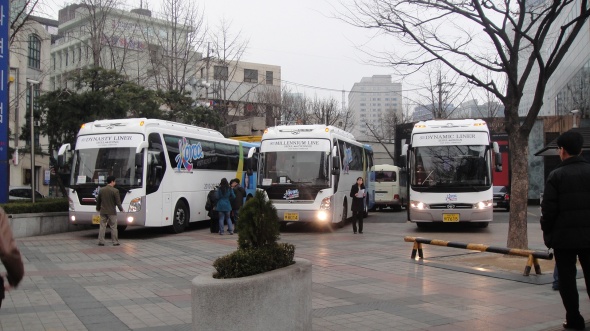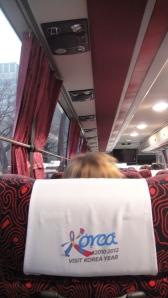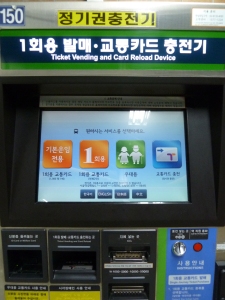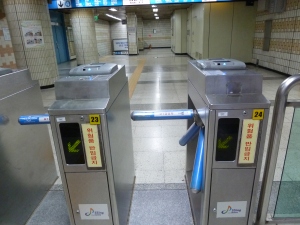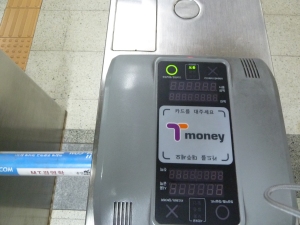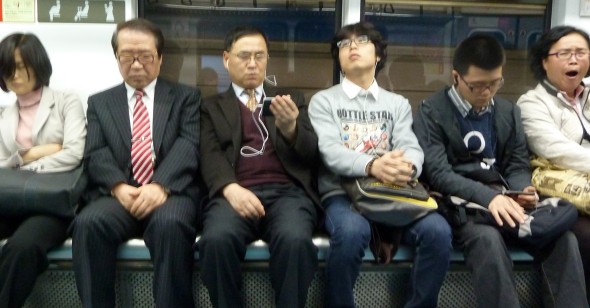Free Tourist Bus – Extension of Operation & Happy New Year
Hello one and all. A very happy 2012 to you. 새해 복 많이 바드새요.
Great news to start off the year! As mentioned in a previous post, there was a free bus operating between Seoul and 3 major Korean cities exclusively for foreigners. This service was for ‘Visit Korea’ year and was due to end on December 31st, 2011.
Well, due to popular demand, and bar a few changes, the service has been extended.
Changes to note are as follows:
- The route to Gyeongju which I took and wrote about previously has now been cut. The routes Seoul-Busan and Seoul-Jeonju will remain open, with one bus travelling in each direction every day.
- The timetable for the Busan bus has changed, now leaving later and stopping at fewer places along the way.
Bus Etiquette 2
In addition to my previous post regarding bus etiquette in Korea, I would like to add a few things.
One key issue to note is that, and this should be obvious, when you are in any other country, please remember that things may seem different to what you are used to. This DOES NOT MEAN they are worse than wherever it is you come from.
Korean people will rarely express any hostility openly to foreigners. What may seem rude to you may not be so in a different culture. Bear this in mind before you decide to react.
A case in point is the shocking tirade uttered by a U.S. citizen on a Korean bus, which was caught on camera:
And this, the admirable video response to the incident by my friend Sonny Side along with Pinnacle the Hustler:
Free Tourist Bus in Korea
Incredibly, Visit Seoul are currently offering a free shuttle bus between Seoul and three major tourist destinations in Korea. This is part of their oddly named Visit Korea Year, which would be all well and good if it weren’t for the fact that it runs from 2010-2012.
The destinations a foreigner in Korea can travel to for free are:
Gyeongju – Korea’s historical capital and former seat of the Jeoseon Dynasty for centuries. This is the best place is Korea to get a sense of historic Korea, and one which has not been rebuilt.
Busan – Korea’s second city, famed for being more laid back than Seoul, and home of the famous Haeundae Beach. It also hosts the expansive Jagalchi Fish Market and good ferry and plane links to close neighbour, Japan.
Jeonju – Supposedly the culinary capital of Korea. All you foodies take note. There are a number of sites of historic interest here also.
This offer runs from now until December 31st, 2011.
The buses are phenomenal; only 3 seats across each row, spacious, comfortable, air conditioned and shiny deluxe buses. Aside from the lengthy visit Korea promo video which plays for a while once the trip has started, it is easy to fall asleep and wake up at your destination.
What’s more, there is NO catch. You don’t have to buy anything, you don’t have to visit any specific places and get herded around like cattle, you just get on at a designated spot and off at your destination. You can travel free either one way or return, and there is no time limit on how long you wait before returning.
The buses travel on every day of the week except Mondays. Plan your trip accordingly.
To reserve your seat, click on this link and have your passport handy. You must reserve in advance, you can’t just rock up and get on the bus.
So far I have only been to Gyeongju and back using this service but I highly recommend it and will certainly take the opportunity to visit Busan and Jeonju using it also before 2012.
How to get a ticket for the subway in Korea – photo guide
New systems can often be confusing. Coming from London, England: home of the world’s very first network of underground railways and stations is now outdated. Korea’s system is new, spacious, modern. As such it is actually more user-friendly. Once you have worked out where you want to go on the subway map, you need to buy a ticket.
In the lobby, there will be a bank of ticket machines and deposit refund devices. First you needn’t worry about the latter. The ticket issuing is in 4 languages (Korean, English, Japanese and Chinese). It is all done by touch screen.
First select the language.
Then select the station you wish to go to. This is alphabetized.
Choose you station, then you will be asked how many tickets you wish to buy. Select the number and insert your money.
The money-eating mouth hole of the machine will light up green to indicate where to feed it.
A few seconds later, you ticket will be spat out, again in a little compartment which will light up.
The cards work much like the oyster of London or octopus cards of Hong Kong. Just touch it to the pad as you walk through the gate, both on your way in and out.
Once your journey is complete, head to the bank of ticket machines in your destination station and find the deposit refund device. Insert your card and you will get a little money back.
The T-Money travel card is only worth buying if you are going to use the transport system more than 20 times. This is the point where you will start to save money from the purchase price of the T-Money card.
Getting in to Seoul – taxi scams
As mentioned previously, the taxi service throughout Korea is one of the most reliable I have ever encountered anywhere in the world. There is always an exception to this rule, and that is at Incheon Airport.
WARNING: Never take a taxi from the airport unless the driver uses the meter. Simple enough, but many a first time traveler to the country has been confounded by the ridiculous conversion rate. 10000 won = $10 and everything is distorted. Usually the scam depletes about $100 from a traveler’s wallet, when they could have taken the extensive subway system for $5.
These guys are usually lurking around in the arrivals area and prey specifically on lone travelers with a backpack, little do the travelers know about the fantastic, fast, cheap AREX subway line to the city centre and numerous, cheap, comfortable buses that head to areas all across the city, all of which are accessible just minutes away.
Be safe, save money.
Navigating the subway system in Seoul
Seoul’s subway system has sprouted 3 new lines from the time I arrived at the end of 2009, to present (mid 2011). Building is still underway, so that by 2013, there should be extensions to the current lines 3 and 9 (orange and gold).
Earlier in 2011, the full length of the airport railroad was finally opened, starting at Seoul station, which along with overland trains to all areas in South Korea, also connects subway lines 1 and 4 (dark and light blue). It travels through some major tourist areas such as Hongik University (Hongdae area), and also connects Gimpo Airport, before terminating at Incheon Airport. Riding the full length, including and transfers prior to entering the airport railroad (provided you complete your transfer within 30 minutes) should cost roughly W5000 ($5). See T-Money card for more information.
Line 2 (green) is the circular line, traversing central Seoul.
Line 3 (orange) runs from the north west to the south east, Line 4 (blue) from north to south, Line 5 (purple) from east to west, Line 6 (brown) from north west, through the centre, but keeping north of the river, to the north east, Line 7 (dark green) from north east to south west, Line 8 (pink) is confined to the south east and Line 9 (gold) from east to west keeping south of the river.
There are other lines that head outside the city or deal with the extremities of the conurbation which I will detail in a different post.
Using the subway system could not be simpler. Look for the touch screen machines by the entry gates inside the subway station. There are options in English, Japanese and Chinese, as well as Korean. For single travel, prices start from W1500 ($1.5), although W500 of the fare is a deposit for the orange travel ticket you will receive.
After completing your journey and exiting the gate in your destination station, look for the ‘Deposit Refund Device’ machine, insert the orange ticket, and it will spit out W500 for you. These are usually situated next to the ticketing machines and are clearly labelled.
The general rule for the fare is any journey under 10km is W1000, then you pay a little extra, usually W100 per additional 5km. Bus fares are similarly priced.
If you are staying in Seoul for a week or more, you might consider buying a T-Money card, as you will likely save money using it on public transportation, however you probably need to make about 20 individual journeys before you start to save money.
Subway and bus etiquette
A few rules for riding the bus or subway to ensure you do not get scowled at nor told off by a disgruntled, elderly Korean lady:
1) Seats at either end of a subway carriage are reserved exclusively for the elderly, disabled or pregnant women. Do not sit in those seats at any time, even if the car seems quiet. Sometimes in the space of one subway station, the train can fill up. Buses have single seats closer to the front that are also reserved.
2) Give up your seat to someone more in need if the train or bus is very full.
3) Wait for people to leave the train before attempting to enter. On the bus, you enter through the front and exit via the middle door only.
4) Sometimes old Korean ladies (affectionately known as ajumas) will barge you out of the way. They are much stronger than they appear. They apparently have right of way and there is nothing you can do about it. It is better to take this slight with good natured aplomb, rather than get annoyed, as this will never get you anywhere and you will just look daft.
5) You can eat on the subway or bus, but be aware that most people sharing the ride with you probably don’t want to smell what you are eating.
6) If you want to fit in with the other Koreans on public transport, you can either a) watch t.v. on your smart phone (oh yes, mobile phones have full connectivity deep under the city even)
b) sleep
c) listen to music
or d) play games on your smart phone
Keeping these things in mind, you should be all set to ride Korea’s public transport hassle-free.
The airport railroad
Early in 2011, the airport railroad opened up, connecting Incheon Airport with Gimpo Airport, the hongdae area and ending at Seoul Station, which in turn connects Seoul to the rest of the country. Look for signs in the airport pointing out the airport railroad or ask for directions at the numerous information kiosks.
Riding the full length, including and transfers prior to entering the airport railroad (provided you complete your transfer within 30 minutes) should cost roughly W5000 ($5). This means you will end up paying about half the price of a bus ticket. See T-Money card for more information.
If you are taking the Airport Railroad from the city centre to the airports, then yu can board at Seoul Station, which also links to Lines 1 & 4 of the subway. The entrance is well posted and is found close to Platforms 12 and 13 in Seoul Station.
It can also be boarded from various other stations in Seoul. See map for more information.

